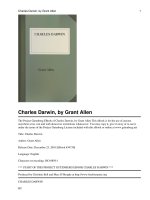The Project Gutenberg EBook of Contributions to the Theory of Natural Selection, by Alfred Russel pot
Bạn đang xem bản rút gọn của tài liệu. Xem và tải ngay bản đầy đủ của tài liệu tại đây (1.98 MB, 939 trang )
The Project Gutenberg EBook of
Contributions to the Theory of Natural
Selection, by Alfred Russel Wallace
This eBook is for the use of anyone
anywhere at no cost and with
almost no restrictions whatsoever. You may
copy it, give it away or
re-use it under the terms of the Project
Gutenberg License included
with this eBook or online at
www.gutenberg.org
Title: Contributions to the Theory of
Natural Selection
A Series of Essays
Author: Alfred Russel Wallace
Release Date: August 29, 2007 [EBook
#22428]
Language: English
*** START OF THIS PROJECT GUTENBERG EBOOK
THEORY OF NATURAL SELECTION ***
Produced by Marilynda Fraser-Cunliffe, LN
Yaddanapudi and
the Online Distributed Proofreading Team
at
(This file was made
using scans of
public domain works from the University of
Michigan Digital
Libraries.)
CONTRIBUTIONS TO
THE THEORY OF
NATURAL
SELECTION.
A Series of Essays.
BY
ALFRED RUSSEL
WALLACE,
AUTHOR OF
“THE MALAY ARCHIPELAGO,” ETC., ETC.
SECOND EDITION, WITH
CORRECTIONS AND ADDITIONS.
New York:
MACMILLAN AND CO.
1871.
[The Right of Translation and
Reproduction is reserved.]
LONDON:
PRINTED BY HEAD, HOLE & CO.,
FARRINGDON STREET,
AND IVY LANE, E.C.
PREFACE.
The present volume consists of essays
which I have contributed to various
periodicals, or read before scientific
societies during the last fifteen years, with
others now printed for the first time. The
two first of the series are printed without
alteration, because, having gained me the
reputation of being an independent
originator of the theory of “natural
selection,” they may be considered to
have some historical value. I have added
to them one or two very short explanatory
notes, and have given headings to
subjects, to make them uniform with the
rest of the book. The other essays have
been carefully corrected, often
considerably enlarged, and in some cases
almost rewritten, so as to express more
fully and more clearly the views which I
hold at the present time; and as most of
them originally appeared in publications
which have a very limited circulation, I
believe that the larger portion of this
volume will be new to many of my friends
and to most of my readers.
I now wish to say a few words on the
reasons which have led me to publish this
work. The second essay, especially when
taken in connection with the first, contains
an outline sketch of the theory of the origin
of species (by means of what was
afterwards termed by Mr. Darwin
—“natural selection,”) as conceived by
me before I had the least notion of the
scope and nature of Mr. Darwin’s labours.
They were published in a way not likely
to attract the attention of any but working
naturalists, and I feel sure that many who
have heard of them, have never had the
opportunity of ascertaining how much or
how little they really contain. It therefore
happens, that, while some writers give me
more credit than I deserve, others may
very naturally class me with Dr. Wells
and Mr. Patrick Matthew, who, as Mr.
Darwin has shown in the historical sketch
given in the 4th and 5th Editions of the
“Origin of Species,” certainly propounded
the fundamental principle of “natural
selection” before himself, but who made
no further use of that principle, and failed
to see its wide and immensely important
applications.
The present work will, I venture to
think, prove, that I both saw at the time the
value and scope of the law which I had
discovered, and have since been able to
apply it to some purpose in a few original
lines of investigation. But here my claims
cease. I have felt all my life, and I still
feel, the most sincere satisfaction that Mr.
Darwin had been at work long before me,
and that it was not left for me to attempt to
write “The Origin of Species.” I have long
since measured my own strength, and
know well that it would be quite unequal
to that task. Far abler men than myself may
confess, that they have not that untiring
patience in accumulating, and that
wonderful skill in using, large masses of
facts of the most varied kind,—that wide
and accurate physiological knowledge,—
that acuteness in devising and skill in
carrying out experiments,—and that
admirable style of composition, at once
clear, persuasive and judicial,—qualities,
which in their harmonious combination
mark out Mr. Darwin as the man, perhaps
of all men now living, best fitted for the
great work he has undertaken and
accomplished.
My own more limited powers have, it
is true, enabled me now and then to seize
on some conspicuous group of
unappropriated facts, and to search out
some generalization which might bring
them under the reign of known law; but
they are not suited to that more scientific
and more laborious process of elaborate
induction, which in Mr. Darwin’s hands
has led to such brilliant results.
Another reason which has led me to
publish this volume at the present time is,
that there are some important points on
which I differ from Mr. Darwin, and I
wish to put my opinions on record in an
easily accessible form, before the
publication of his new work, (already
announced,) in which I believe most of
these disputed questions will be fully
discussed.
I will now give the date and mode of
publication of each of the essays in this
volume, as well as the amount of
alteration they have undergone.
I.—On the Law which has Regulated the
Introduction of New Species.
First published in the “Annals and
Magazine of Natural History,” September,
1855. Reprinted without alteration of the
text.
II.—On the Tendency of Varieties to
Depart indefinitely from the Original
Type.
First published in the “Journal of the
Proceedings of the Linnæan Society,”
August, 1858. Reprinted without alteration
of the text, except one or two grammatical
emendations.
III.—Mimicry and other Protective
Resemblances among Animals.
First published in the “Westminster
Review,” July, 1867. Reprinted with a
few corrections and some important
additions, among which I may especially
mention Mr. Jenner Weir’s observations
and experiments on the colours of the
caterpillars eaten or rejected by birds.
IV.—The Malayan Papilionidæ, Or
Swallow-Tailed Butterflies, as Illustrative
of the Theory of Natural Selection.
First published in the “Transactions of
the Linnæan Society,” Vol. XXV. (read
March, 1864), under the title, “On the
Phenomena of Variation and Geographical
Distribution, as illustrated by the
Papilionidæ of the Malayan Region.”
The introductory part of this essay is
now reprinted, omitting tables, references
to plates, &c., with some additions, and
several corrections. Owing to the
publication of Dr. Felder’s “Voyage of the
Novara” (Lepidoptera) in the interval
between the reading of my paper and its
publication, several of my new species
must have their names changed for those
given to them by Dr. Felder, and this will
explain the want of agreement in some
cases between the names used in this
volume and those of the original paper.
V.—On Instinct in Man and Animals.
Not previously published.
VI.—The Philosophy of Birds’ Nests.
First published in the “Intellectual
Observer,” July, 1867. Reprinted with
considerable emendations and additions.
VII.—A Theory of Birds’ Nests; Showing
the relation of certain differences Of
Colour in Birds To their mode of
Nidification.
First published in the “Journal of
Travel and Natural History” (No. 2),
1868. Now reprinted with considerable
emendations and additions, by which I
have endeavoured more clearly to
express, and more fully to illustrate, my
meaning in those parts which have been
misunderstood by my critics.
VIII.—Creation by Law.
First published in the “Quarterly
Journal of Science,” October, 1867. Now
reprinted with a few alterations and
additions.
IX.—The Development of Human Races
under the Law of Natural Selection.
First published in the
“Anthropological Review,” May, 1864.
Now reprinted with a few important
alterations and additions. I had intended to
have considerably extended this essay, but
on attempting it I found that I should
probably weaken the effect without adding
much to the argument. I have therefore
preferred to leave it as it was first written,
with the exception of a few ill-considered
passages which never fully expressed my
meaning. As it now stands, I believe it
contains the enunciation of an important
truth.
X.—The Limits of Natural Selection as
applied to Man.
This is the further development of a
few sentences at the end of an article on
“Geological Time and the Origin of
Species,” which appeared in the
“Quarterly Review,” for April, 1869. I
have here ventured to touch on a class of
problems which are usually considered to
be beyond the boundaries of science, but
which, I believe, will one day be brought
within her domain.
For the convenience of those who are
acquainted with any of my essays in their
original form, I subjoin references to the
more important additions and alterations
now made to them.
ADDITIONS AND CORRECTIONS TO
THE ESSAYS AS ORIGINALLY
PUBLISHED.
Essays I. and II. are unaltered, but
short notes are added at pp. 19, 24, 29,
and 40.
III.—Mimicry, and other Protective
Resemblances among Animals.
PAGE
53
Additional illustration of protective
colouring in the case of the wood-
dove and the robin.
63
On moths resembling bird’s dung
and mortar.
86
Correction of some names of
African Papilios and a reference to
Mr. Trimen’s observations.
89
Mr. Jenner Weir’s observation on
birds which refused to eat
Spilosoma menthrasti.
102
An additional case of snake
mimicry in Oxyrhopus trigeminus.
107
Mr. Salvin’s case of mimicry among
hawks.
113 Name, Diadema anomala, added.
117
to
122.
Use of gay colours in caterpillars,
with an account of Mr. Jenner
Weir’s and Mr. Butler’s
observations.
IV.—The Malayan Papilionidæ or
Swallow-tailed Butterflies, as
illustrative of the Theory of Natural
Selection.
135
to
140.
Additions to the discussion on the
rank of the Papilionidæ, and on the
principles which determine the
comparative rank of groups in the
animal kingdom.
164
Illustration of variability from Mr.
Baker’s revision of the British
Roses.
173
Additional facts, on local variations
of colour.
196
Additional genus of birds
(Ceycopsis) peculiar to Celebes.
199,
200.
Concluding remarks.
VI.—The Philosophy of Birds’ Nests.
218
On nesting of Terns and Gulls,
rewritten.
220
to
222.
Daines Barrington, and others, on
the song of birds.
223
On young birds learning to build, by
memory and imitation.
224
Levaillant, on mode of nest-
building.
229
On imperfect adaptation in birds’
nests.
VII.—A Theory of Birds’ Nests.
231,
232.
Introductory passages modified,
with some omissions.
233
How modifications of organization
would affect the form of the nest.
235
Illustration from the habits of
children and savages.
235, Objection to term “hereditary habit”
236. answered.
237
Passage rewritten, on more or less
variable characters in relation to
nidification.
248
On males choosing or rejecting
females, and on the various modes
in which colour may be acquired by
female birds.
249
On probable ancestral colours of
female birds.
255
Protective colouring of the
Waxwing.
VIII.—Creation by Law.
293 Amount of variation in dogs.
296,
297.
The “Times” on Natural Selection.
298
On intermediate or generalized
to
300.
forms of extinct animals as an
indication of transmutation or
development.
302
Tabular demonstration of the Origin
of Species by Natural Selection.
IX.—The development of Human Races,
under the law of Natural Selection.
316
On colour as perhaps correlated
with immunity from disease in man.
326,
327.
On the probable future development
of man.
330 Concluding paragraph rewritten.
London, March, 1870.
PREFACE TO THE
SECOND EDITION.
The flattering reception of my Essays by
the public and the press having led to a
second edition being called for within a
year of its first publication, I have taken
the opportunity to make a few necessary
corrections. I have also added a few
passages to the 6th and 7th Essays, and
have given two notes, explanatory of some
portions of the last chapter which appear
to have been not always understood.
These additions are as follows:—
To avoid altering the paging the
additional pages now given have been
lettered.
1st Ed. 2nd Ed.
221 221
Additional facts as to
birds acquiring the song
of other species.
223
223a}
223b}
Mr. Spruce’s remarks on
young birds pairing with
old.
228
228a}
228b}
Pouchet’s observations
on a change in the nests
of swallows.
229 —
Passage omitted about
nest of Golden Crested
Warbler, which had
been inserted on
Rennie’s authority, but
has not been confirmed









